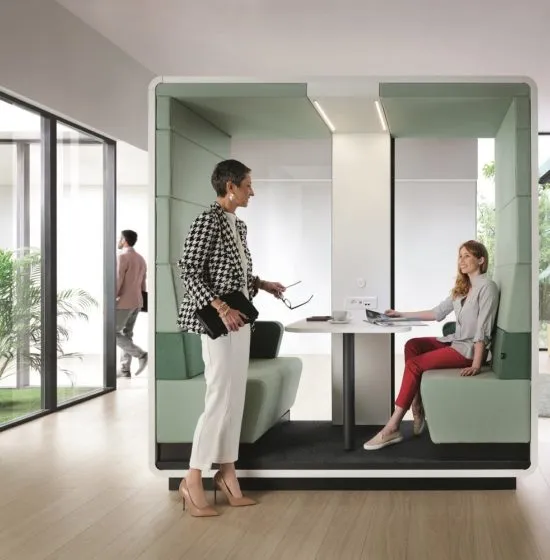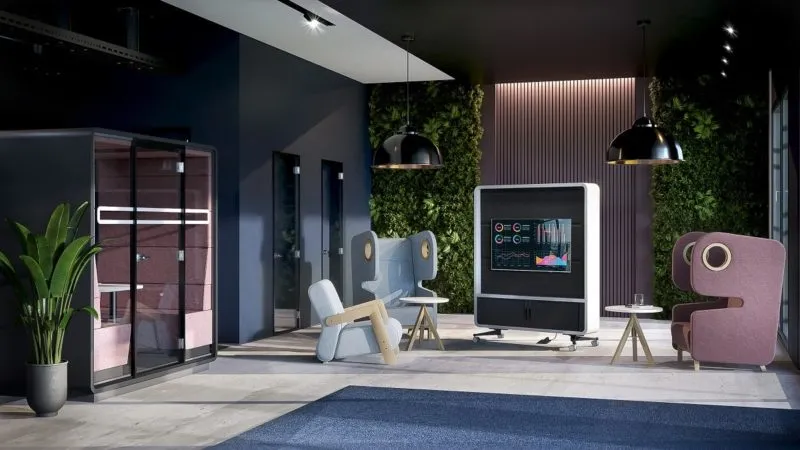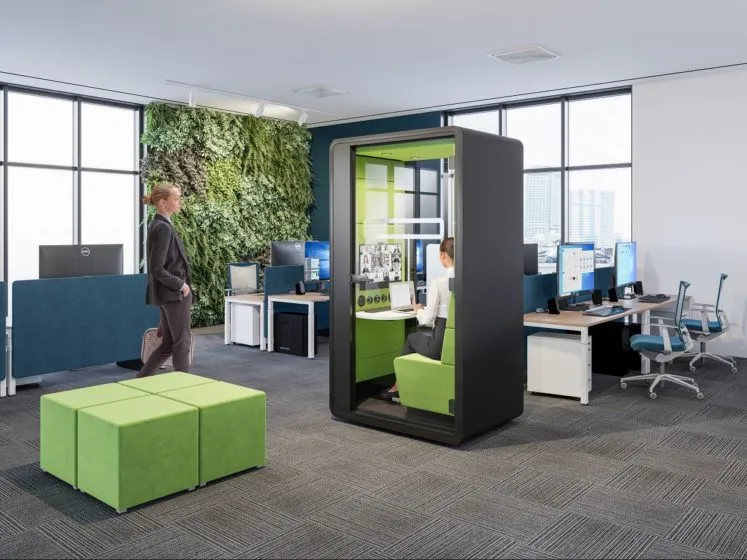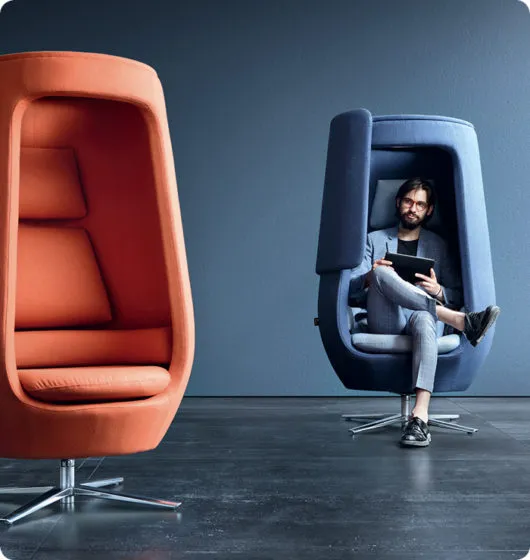Curbing digital stress in a hybrid work world…
- Posted on: 9 November 2023
- By: Hushoffice Team
Changing technologies, information overload, and the need for constant online communication can equal serious stress for your employees. Without smart measures, there is no relief from pressing connectedness. Acoustic office booths provide the noise-free environment and mental refuge needed.
Digital stress in a hybrid work world – tl;dr
Digital stress is, in a few words, angst from technology use and abuse. It is pronounced in remote work contexts, with employees spending more time with screens than with people. Specific forms of digital stress include techno-overload (also called technostress), techno-insecurity, and techno-invasion.
To curb digital stress, employees must become more digitally mindful. To help, encourage your employees to tech-free meetings, prioritize genuine digital detoxes during vacations and weekends, and set a non-negotiable “turn off” time for each evening. It can also help to define strict weekend rules regarding email checks and disable unnecessary push notifications.
Hushoffice pods are exceptional solutions to the digital stress problem. They function as sanctuaries from the unpredictable noise, visual activities, and overall sensory overload that accelerate stress and impede productivity in the open space office.
Remote work and digital stress — new challenges of the XXI century
Digital stress is angst from technology use. It is common in today’s landscape, with employees spending more time with screens than with people. Excessive screen time leads to eye strain, headaches, and other physical discomforts. Worse, it is socially isolating.
Remote work involves a high volume of digital information: emails, messages, documents, video meetings, etc.
Managing and processing this overload of information can be overwhelming. It can lead to cognitive fatigue. Especially in cases where the employee can’t meet with supervisors or colleagues regularly to gain perspective.
What is digital stress? What are its consequences?
Digital stress, also known as digital or technology-induced stress, is the negative psychological and physical effects of too much technology and online platform use. It is a modern experience that has emerged with the boom of devices and constant connectivity, exacerbated by the recent adoption of remote work worldwide.
Psychological effects can include anxiety, mental overload, and addiction to screens.
Physical effects can include computer vision syndrome, sleep disruption, and repetitive stress injuries like CTS. On the whole, chronic digital stress can lead to serious burnout on the job, hurting performance and the employee’s sense of well-being.
Understanding the causes of digital stress in remote workers is the first step.
Techno-overload, techno-insecurity, and techno-invasion are all subsets of the problem. Without quiet, self-contained work booths like hushHybrid, employees on open floors can be left feeling inundated by everyone else’s keyboard clicks, cell phone ringtones, and mental energy.
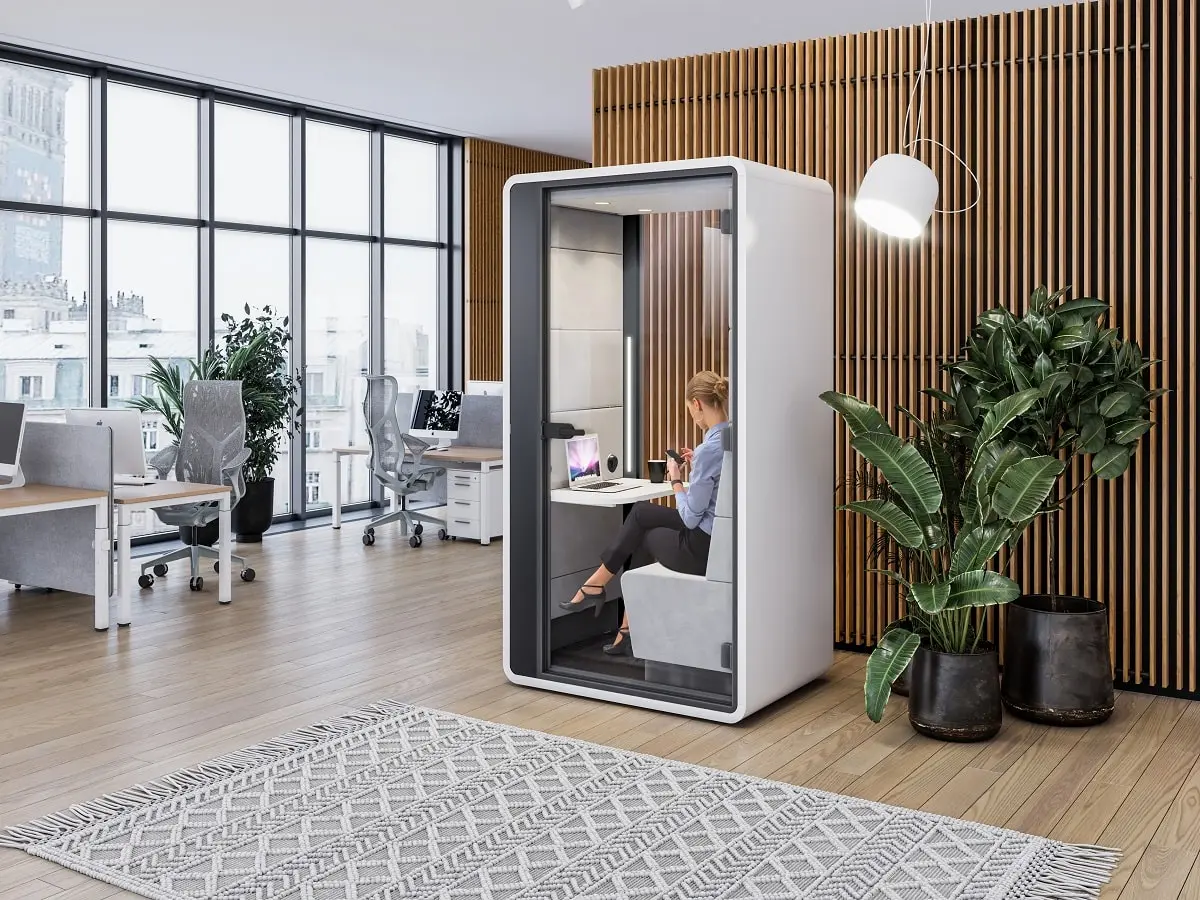
Techno-overload or technostress…
“People experience technostress when they cannot adapt to or cope with information technologies in a healthy manner,” says Wikipedia. A compulsion to be connected and share updates 24/7 results, as one feels forced to respond to work queries immediately, habitually multi-tasking.
Constant connectivity creates a feeling of always being reachable and can lead to anxiety.
Video meetings, a critical feature of remote work, are infamous for leading to “Zoom fatigue” or digital exhaustion. As one example of many, back-to-back video calls can be mentally depleting due to the necessity of sustained focus on a screen for extended periods.
Technostress is a scientifically proven phenomenon.
Unsurprisingly, employees lacking control over their work hours or unaccustomed to remote work deal with greater techno-fatigue. Unfortunately, this cohort exhibits an array of negative effects on their occupational health including reduced productivity levels.
Techno-insecurity…
When employees fear losing their jobs to others with a better feel for new tech, they have techno-insecurity. It is shown to increase moral disengagement, causing the loss of ethical standards. This has consequences at work, as shared morals are vital to an atmosphere of trust and respect.
Techno-invasion — poor work-life imbalance…
This refers to one’s sense of being “always exposed” online due to reachability anywhere and at any time. Here, the work-day, for some, has no end. In cases of overwhelm, private one-person booths like hushHybrid help by giving the employee momentary breaks from all the figurative and literal noise.
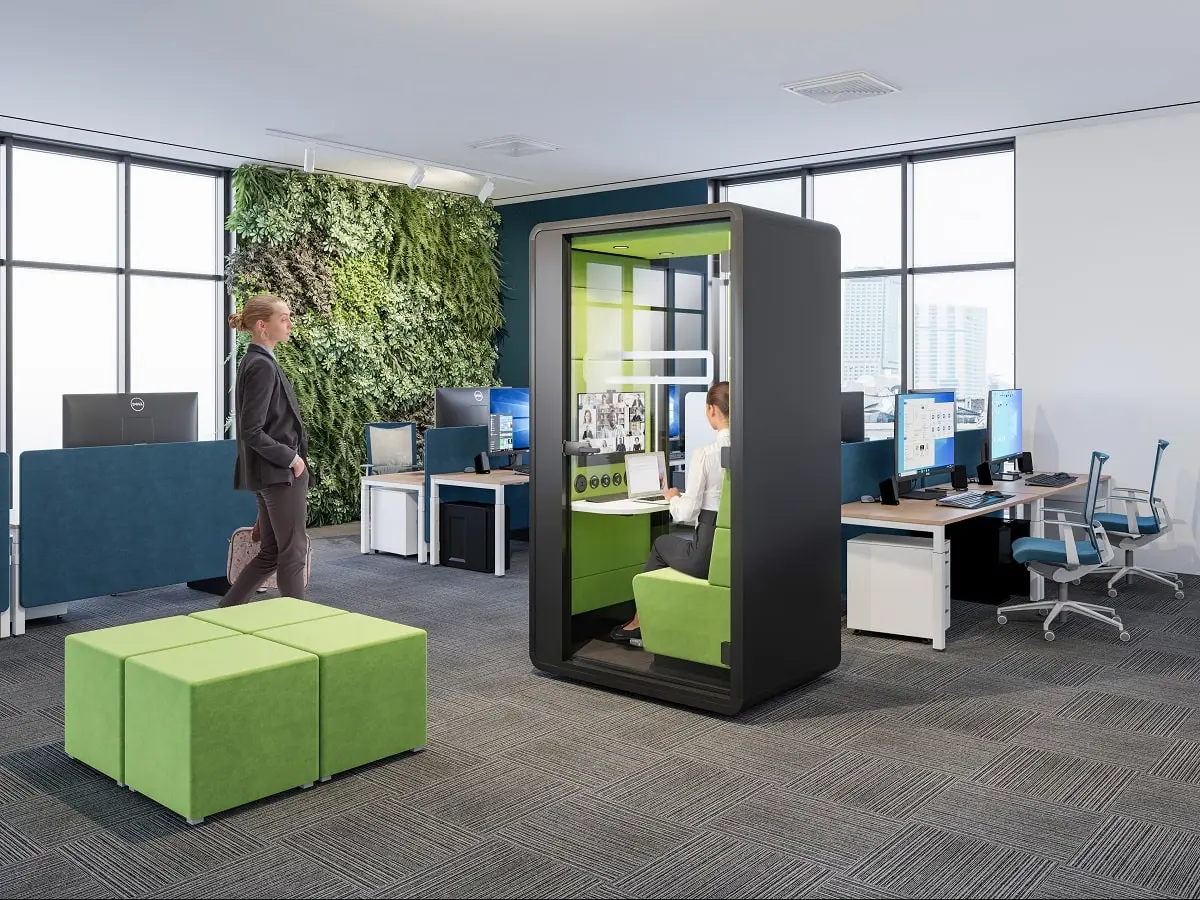
Boundaries are critical in a remote work context.
Techno-invasion makes an employee feel their space is often violated. Without conscious consideration, the lines between work and personal life get blurred in a remote context. This is especially stressful for employees who feel they are always “on” and never get a true break.
Read: Digital mindfulness is a matter of well-being
So is online communication a convenience or a problem?
Technology is a double-edged sword, presenting either ease or anxiety depending on how it is wielded. On one hand, it gives impressive convenience by allowing people to connect, collaborate, and access information across vast distances. It empowers remote work, fosters global partnerships, and facilitates access to a wealth of knowledge. However, digital stress, information overload, and the negative impacts on mental and physical health are considerable
– says Mateusz Barczyk, Senior Brand Manager, Hushoffice.
Still, used mindfully, online communication remains a tremendous tool. Striking a balance, using technology intentionally, and establishing boundaries can help employees navigate the challenges and, thus, unlock the full potential of digital working.
Curbing employee overstimulation is imperative.
It is essential for employees and employers to establish clear boundaries, encourage breaks, and promote healthy work habits. Realizing the advantages of remote work by instituting dependable measures that address digital stress is the way to maintain a hybrid workforce’s well-being.
Acoustic booths — the perfect noise-free working environment
Pods are special solutions to the digital stress problem. They offer a sanctuary from the barrage of noise, visual distractions, and sensory overload that compounds stress and hinders productivity in the open office. Consider hushAccess.L for large team meetings, for instance.
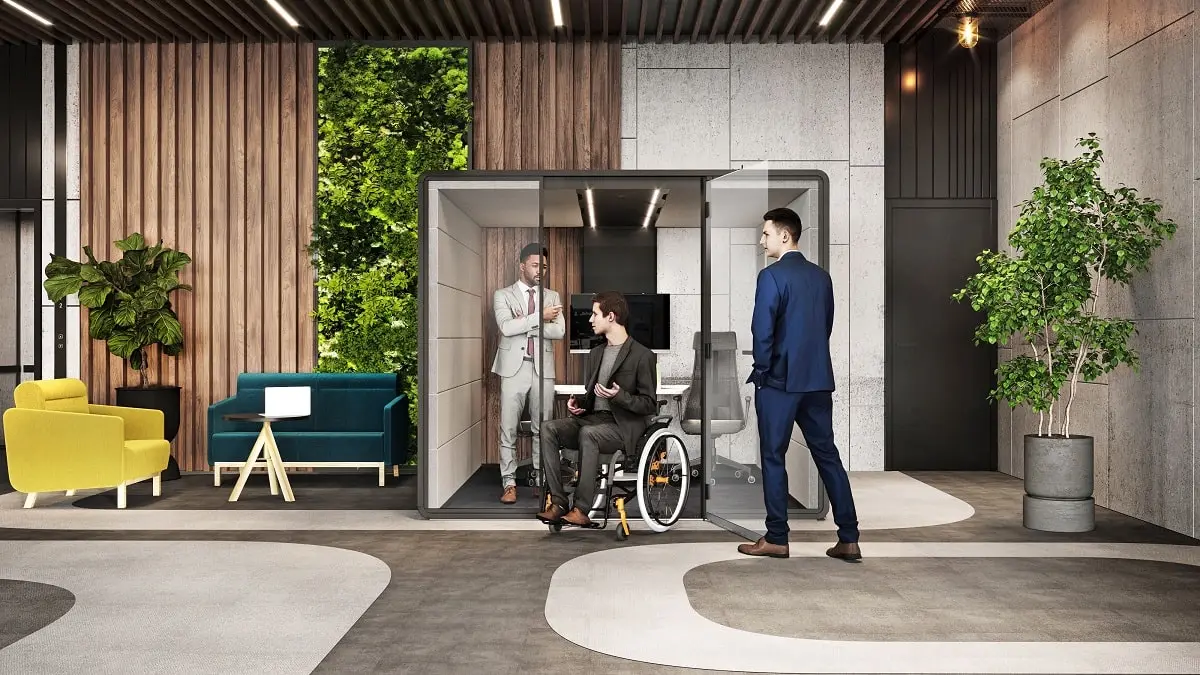
Privacy and silence in the workplace are imperative
Private, quiet pods like hushMeet allow for confidential discussions, the handling of sensitive information, and independent work without the discomfort of being constantly observed or listened to. Moreover, a space like hushMeet is a retreat for quick breaks or moments of meditation.
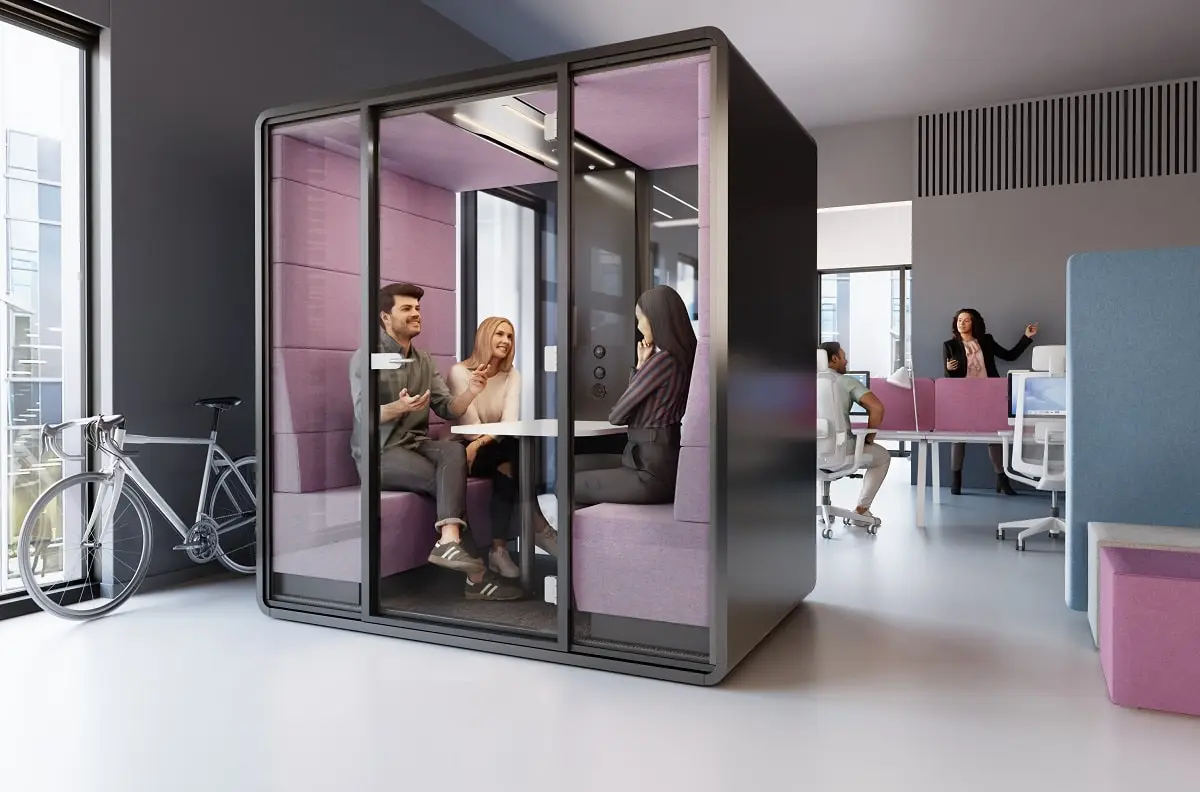
In the broader context of the modern workplace, such private and quiet environments as pods help quell overstimulation, benefitting well-being, ultimately shaping a more balanced and productive work experience on the whole
– says Mateusz Barczyk, Senior Brand Manager, Hushoffice.
Acoustic pods support concentration by minimizing the interference typical of open floors
They are finely engineered environments with brilliantly layered sound-absorbing materials for reduced noise distractions. They also provide comforting visual privacy by blocking out visual activities. Inside, one can focus without a self-conscious sense of being watched.
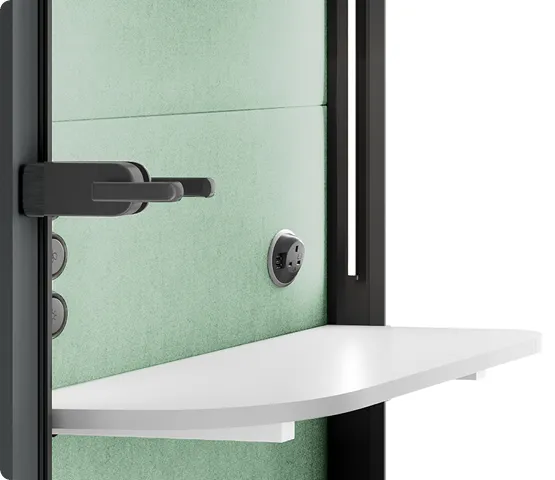
Pods give employees more control over their bandwidth (through control over their space).
Adjustable lighting within pods like hushPhone lets you fine-tune your immediate space’s illumination to the moment’s task. This can reduce eye strain and at the same time boost performance, with the task matched by the right ambient lighting.
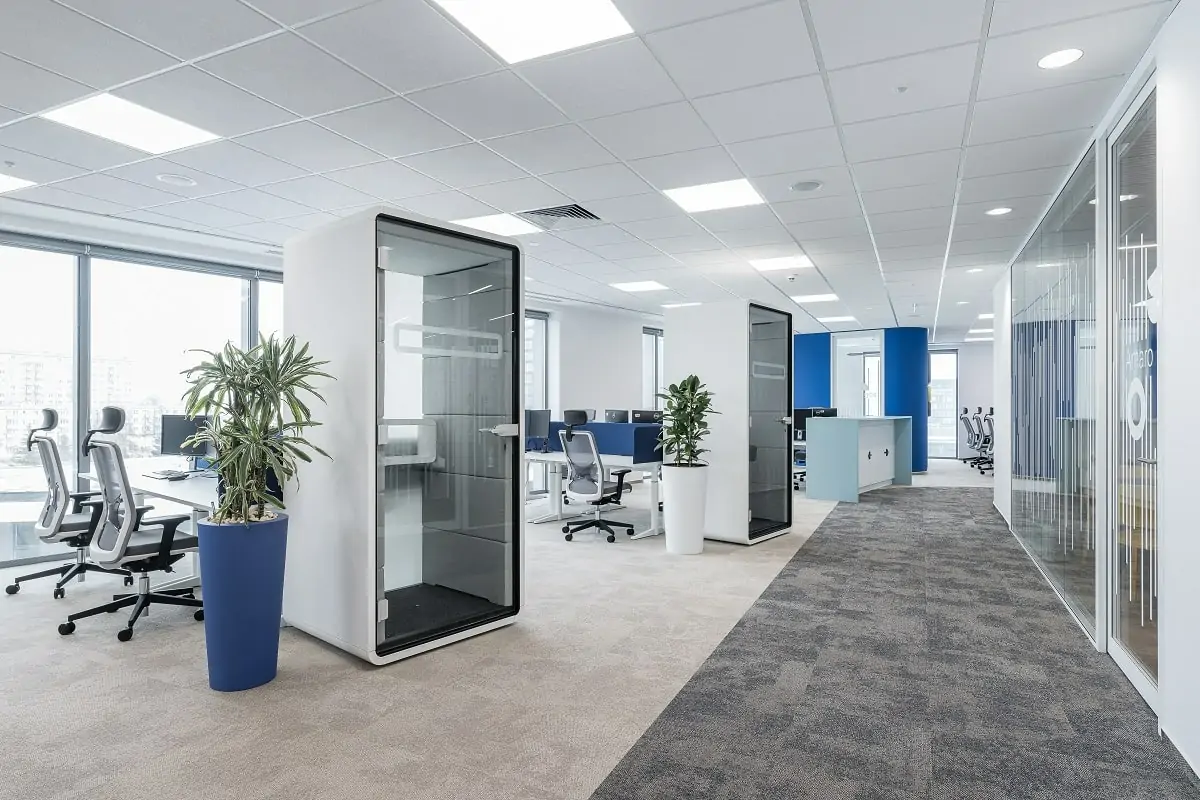
So can acoustic booths reduce digital stress?
Absolutely. They are the secluded, soundproof environment that shields from the cacophony of a bustling office. Auditory stressors are minimized. The anxiety associated with constant background noise is eliminated.
Isolation equates to concentration in a pod.
Office pods and booths facilitate stronger focus and clearer thinking. Inside one, employees work with greater ease thanks to the booth’s quiet, calm setting. The mental load imposed by digital distractions like the rings and pings of others’ devices is hushed.
Comfort above all else in an acoustic office booth.
Booths like hushMeet incorporate ergonomically designed furnishings, optimal lighting, and ventilation control, offering the employee a cozy and personalized workspace. The independence of working in a booth gives a sense of sovereign space and guaranteed privacy. Thus, the social pressures of open office environments and the feeling of constantly being observed fade away in the distance
– says Mateusz Barczyk, Senior Brand Manager, Hushoffice.
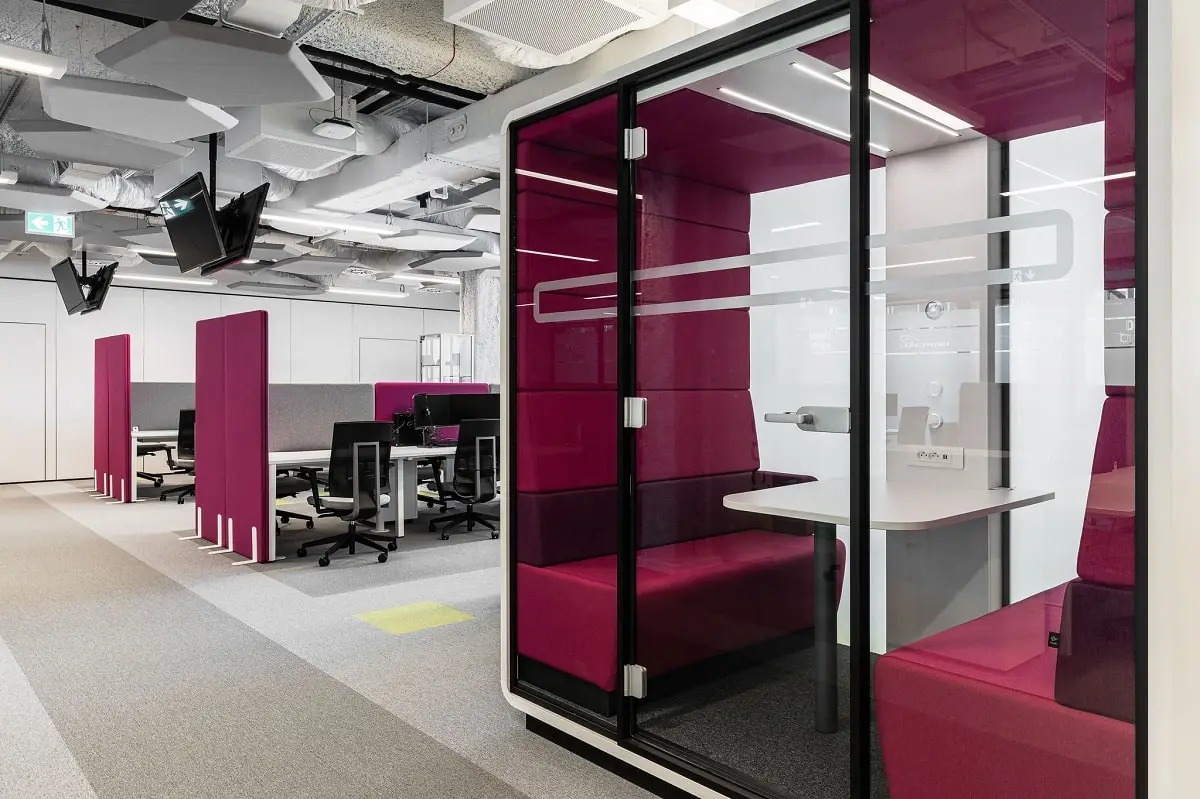
Want to learn 9 steps towards digital mindfulness? Check out our blog on the topic.
Digital well-being is about technology that supports employees.
Achieving harmony between humans and their devices is tricky work. It requires ongoing efforts in design, management, and personal responsibility. But when harmony is had, a more productive and satisfying work environment results.
We believe pods are part of the equation for the privacy, quiet, and peace they provide. Check out the Hushoffice line of acoustic work and meeting pods here.
Digital stress in a hybrid work world – tl;dr
Digital stress is, in a few words, angst from technology use and abuse. It is pronounced in remote work contexts, with employees spending more time with screens than with people. Specific forms of digital stress include techno-overload (also called technostress), techno-insecurity, and techno-invasion.
To curb digital stress, employees must become more digitally mindful. To help, encourage your employees to tech-free meetings, prioritize genuine digital detoxes during vacations and weekends, and set a non-negotiable “turn off” time for each evening. It can also help to define strict weekend rules regarding email checks and disable unnecessary push notifications.
Hushoffice pods are exceptional solutions to the digital stress problem. They function as sanctuaries from the unpredictable noise, visual activities, and overall sensory overload that accelerate stress and impede productivity in the open space office.
Digital stress – frequently asked questions
What is an example of technostress?
“Zoom fatigue” is a common type of technostress or the negative impact of technology on an individual’s mental and physical well-being. It describes cases in which the employee has mental exhaustion and relative isolation from a high volume of video calls.
What is techno-invasion?
Techno-invasion describes situations where technology, such as constant notifications, surveillance, or excessive use of digital tools, intrudes upon employees’ work-life balance, causing stress and hindering their performance.
What is techno-insecurity?
Techno-insecurity describes unease, vulnerability, or lack of confidence an employee may experience when they are concerned about losing their job to someone else with a stronger grip on the latest tech.

